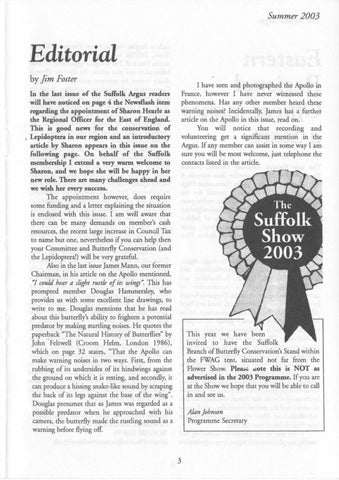The SuffolkArgus
GoGreen & Recycle & Raise Cash for Butterfly Conservation by David Bridges Butterfly Conservation has recently signed up to a recycling scheme with Reclaim-it, a company that collects empty laser toner cartridges and ink.jet printer cartridges and pays us between 25p and £6 each (depending on type).
Summer 2003 For small quantities of inkjet cartridges, I can supply reply paid envelopes for you to send your cartridges direct to Reclaim-it. For large quantities (30+ inkjet and 12+ laser toner cartridges) the cartridges should be parcelled up for Reclaim-it to collect. They will send a courier round to you to pick up your parcel. For larger •collection points, e.g. an office, Reclaim-it can provide a large collection bin which they will collect once full. In each case Butterfly Conservation will receive a cheque within 14 days for the cartridges you recycle.
Do's and Don't's • Do ensure the cartridges you return are not damaged. • Do return your cartridges in the reply paid envelopes (which are pre-coded) or a coded collection bin so Reclaim-it will know to send Butterfly Conservation a cheque. If you are making up a parcel contact me first to get Butterfly Conservation's reference number. • Do pack your cartridges carefully in their original packaging, a piece of bubblewrap or the box your new cartridge came in.
This excellent fundraising opportunity prevents empty cartridges being thrown away and being sent to landfill sites, and can help Butterfly Conservation raise some useful cash for its conservation work!
• Do not return Epson inkjet cartridges or remanufactured cartridges. • Do not put tape or sellotape on the cartridges themselves as this can damage them.
How does the scheme work? The majority of inkjet and laser toner cartridges in use today have a value when empty and can be recycled. Please note that Epson inkjet cartridges and most re-manufactured cartridges are not eligible under this scheme and should not be returned. All you have to do to help BC is to start collecting empty cartridges! Why not ask your friends, relatives, colleagues and local businesses to give you their empty cartridges too? Free collection - Reclaim-it provide a free collection scheme.
To get a supply of reply paid envelopes please send an A4 s.a.e. (19p stamp) to David Bridges, Butterfly Conservation, Manor Yard, East Lulworth, Dorset BH20 5QP. If you think you can place a large collection bin in a local office or would like more information about this scheme please email your address to me at butterfly.conservation@tesco.net or telephone me on 01403 256175.
Editorial by Jim Foster In the last issue of the Suffolk Argus readers will have noticed on page 4 the Newsflash item regardingthe appointment of Sharon Hearle as the Regional Officer for the East of England. This is good news •for the conservation of , Lepidopterain our region and an introductory article by Sharon appears in this issue on the following page. On behalf of the Suffolk membership I extend a very warm welcome to Sharon, and we hope she will be happy in her new role. There are many challenges aheadand we wish her every success. The appointment however, does require some funding and a letter explaining the situation is enclosed with this issue. I am well aware that there can be many demands on member's cash resources, the recent large increase in Council Tax to name but one, nevertheless if you can help then your Committee and Butterfly Conservation (and the Lepidoptera!) will be very grateful. Also in the last issue James Mann, our former Chairman, in his article on the Apollo mentioned, "I could hear a slight rustle of its wing.r".This has prompted member Douglas Hammersley, who provides us with some excellent line drawings, to write to me. Douglas mentions that he has read about this butterfly's ability to frighten a potential predator by making startling noises. He quotes the paperback "The Natural History of Butterflies" by John ·Feltwell (Croom Helm, London 1986), which on page 32 states, 'That the Apollo can make warning noises in two ways. First, from the rubbing of its undersides of its hindwings against the ground on which it is resting, and secondly, it can produce a hissing snake-like sound by scraping the back of its legs against the base of the wing". Douglas presumes that as James was regarded as a possible predator when he approached with his camera, the bunerfly made the rustling sound as a warning before flying off.
I have seen and photographed the Apollo in France, however I have never witnessed these phenomena. Has any other member heard these warning noises? Incidentally, James has a further article on the Apollo in this issue, read on. You will notice that recording and volunteering get a significant mention in the Argus.If any member can assist in some way I am sure you will be most welcome, just telephone the contacts listed in the article.
This year we have been invited to have the Suffolk Branch of Butterfly Conservation's Stand within the FWAG tent, situated not far from the Flower Show. PI-.; uote this is NOT as advertisedin the 2003 Programme.If you are at the Show we hope that you will be able to call in and see us.
AlanJohnson Programme Secretary
Many thanks.
22
3









